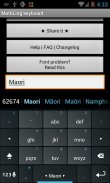




Maori Keyboard Plugin

คำอธิบายของMaori Keyboard Plugin
Maori Dictionary plugin for Multiling O Keyboard autocorrect and word prediction
Instruction:
⑴ Install this plugin and Multiling O Keyboard. https://play.google.com/store/apps/details?id=kl.ime.oh
⑵ Run O Keyboard and follow its setup guide.
⑶ Slide space bar to switch languages.
If you have font issue, read this: http://honsoapps.appspot.com/1/ma.html
Wikipedia:
Maori or Māori (/ˈmaʊri/; Māori pronunciation: [ˈmaː.ɔ.ɾi]) is an Eastern Polynesian language spoken by the Māori people, the indigenous population of New Zealand. Since 1987, it has been one of New Zealand's official languages. It is closely related to Cook Islands Māori, Tuamotuan, and Tahitian.
According to a 2001 survey on the health of the Māori language, the number of very fluent adult speakers was about 9% of the Māori population, or 30,000 adults.[1] A national census undertaken in 2006 says that about 4% of the New Zealand population,[4] or 23.7% of the Maori population could hold a conversation in Maori about everyday things
Name
The English word comes from the Maori language, where it is spelled "Māori". In New Zealand the Maori language is commonly referred to as Te Reo [tɛ ˈɾɛ.ɔ] "the language", short for te reo Māori.
The spelling "Maori" (without macron) is standard in English outside New Zealand in both general[6] and linguistic[7] usage. The Maori-language spelling "Māori" (with macron) has become common in New Zealand English in recent years, particularly in Maori-specific cultural contexts,[8][9] although the traditional English spelling is still prevalent in general media and government use.[10][11]
Preferred and alternate pronunciations in English vary by dictionary, with /ˈmaʊəri/ being most frequent today, and /mɑːˈɒri/, /ˈmɔri/, and /ˈmɑri/ also given.[12] Spelling pronunciations as /meɪˈɔəri/ are also encountered in popular speech[13][14] in the United States particularly, but are considered incorrect.
Official status
New Zealand has three official languages – English, Māori and New Zealand Sign Language.[15] Māori gained this status with the passing of the Māori Language Act in 1987.[16] Most government departments and agencies have bilingual names; for example, the Department of Internal Affairs Te Tari Taiwhenua, and places such as local government offices and public libraries display bilingual signs and use bilingual stationery. New Zealand Post recognises Māori place-names in postal addresses. Dealings with government agencies may be conducted in Māori, but in practice, this almost always requires interpreters, restricting its everyday use to the limited geographical areas of high Māori fluency, and to more formal occasions, such as during public consultation.
An interpreter is on hand at sessions of Parliament, in case a Member wishes to speak in Māori. In 2009, Opposition parties held a filibuster against a local government bill, and those who could recorded their voice votes in Māori, all faithfully interpreted.[17]
A 1994 ruling by the Privy Council[18] in the United Kingdom held the New Zealand Government responsible under the Treaty of Waitangi (1840) for the preservation of the language. Accordingly, since March 2004, the state has funded Māori Television, broadcast partly in Māori. On 28 March 2008, Māori Television launched its second channel, Te Reo, broadcast entirely in the Māori language, with no advertising or subtitles. In 2008, Land Information New Zealand published the first list of official place names with macrons, which indicate long vowels. Previous place name lists were derived from systems (usually mapping and GIS systems) that could not handle macrons
</div> <div jsname="WJz9Hc" style="display:none">ปลั๊กอินเมารีพจนานุกรมสำหรับ MultiLing O แป้นพิมพ์แก้ไขอัตโนมัติและการทำนายคำ
คำแนะนำ:
⑴ติดตั้งปลั๊กอินนี้และ MultiLing O แป้นพิมพ์ https://play.google.com/store/apps/details?id=kl.ime.oh
⑵เรียก O แป้นพิมพ์และปฏิบัติตามคำแนะนำการติดตั้งของ
แถบพื้นที่สไลด์⑶เพื่อสลับภาษา
หากคุณมีปัญหาตัวอักษรอ่าน: http://honsoapps.appspot.com/1/ma.html
วิกิพีเดีย:
เมารีหรือเมารี (/ maʊri /; Māoriออกเสียง: [maː.ɔ.ɾi]) เป็นภาษาตะวันออกโปลีนีเซียที่พูดโดยคนMāoriประชากรพื้นเมืองของนิวซีแลนด์ ตั้งแต่ปี 1987 จะได้รับหนึ่งในภาษาราชการของประเทศนิวซีแลนด์ มันเป็นเรื่องที่เกี่ยวข้องอย่างใกล้ชิดกับหมู่เกาะคุกเมารี, Tuamotuan และตาฮิติ
ตามการสำรวจ 2,001 ต่อสุขภาพของภาษาเมารี, จำนวนของลำโพงผู้ใหญ่ได้อย่างคล่องแคล่วมากเป็นประมาณ 9% ของประชากรMāoriหรือ 30,000 ผู้ใหญ่. [1] การสำรวจสำมะโนประชากรแห่งชาติดำเนินการในปี 2006 กล่าวว่าประมาณ 4% ของใหม่ ประชากรนิวซีแลนด์ [4] หรือ 23.7% ของประชากรชาวเมารีสามารถถือในการสนทนาเกี่ยวกับสิ่งที่ชาวเมารีในชีวิตประจำวัน
ชื่อ
คำภาษาอังกฤษมาจากภาษาเมารีซึ่งจะมีการสะกดคำว่า "เมารี" ในนิวซีแลนด์ภาษาเมารีเป็นปกติจะเรียกว่าเตโอ [tɛɾɛ.ɔ] "ภาษา" สั้นเต้ REO เมารี
การสะกดคำ "เมารี" (โดยไม่ต้องสระ) เป็นมาตรฐานในภาษาอังกฤษนอกประเทศนิวซีแลนด์ในทั้งทั่วไป [6] และภาษา [7] การใช้งาน การสะกดคำภาษาเมารี "เมารี" (กับสระ) ได้กลายเป็นเรื่องธรรมดาในภาษาอังกฤษนิวซีแลนด์ในปีที่ผ่านมาโดยเฉพาะอย่างยิ่งในบริบททางวัฒนธรรมเมารีเฉพาะ [8] [9] แม้ว่าสะกดคำภาษาอังกฤษแบบดั้งเดิมยังคงเป็นที่แพร่หลายในสื่อทั่วไปและรัฐบาล การใช้งาน. [10] [11]
ที่ต้องการและออกเสียงในภาษาอังกฤษอื่นแตกต่างกันตามพจนานุกรมด้วย / maʊəri / วันนี้เป็นที่พบบ่อยที่สุดและ / mɑːɒri / / mɔri / และ / mɑri / นอกจากนี้ยังได้รับ. [12] ออกเสียงการสะกดคำเป็น / meɪɔəri / จะพบยังอยู่ในคำพูดที่เป็นที่นิยม [13] [14] ในประเทศสหรัฐอเมริกาโดยเฉพาะอย่างยิ่ง แต่จะถือว่าไม่ถูกต้อง
สถานะอย่างเป็นทางการ
นิวซีแลนด์มีสามภาษาอย่างเป็นทางการ - ภาษาอังกฤษ, ภาษาเมารีและนิวซีแลนด์เข้าสู่ระบบภาษา [15] Māoriได้รับสถานะนี้มีการผ่านไปของพระราชบัญญัติภาษาเมารีในปี 1987 [16] ส่วนใหญ่หน่วยงานภาครัฐและหน่วยงานที่มีชื่อภาษา. ตัวอย่างเช่นกรมกิจการภายใน Te Tari Taiwhenua และสถานที่ดังกล่าวเป็นหน่วยงานภาครัฐท้องถิ่นและห้องสมุดประชาชนแสดงสัญญาณสองภาษาและใช้ภาษาเขียน นิวซีแลนด์โพสต์ตระหนักMāoriชื่อสถานที่ในที่อยู่ทางไปรษณีย์ การติดต่อกับหน่วยงานภาครัฐอาจจะดำเนินการในMāori แต่ในทางปฏิบัตินี้มักจะต้องใช้ล่าม จำกัด การใช้ในชีวิตประจำวันไปยังพื้นที่ทางภูมิศาสตร์ที่ จำกัด ของความคล่องแคล่วMāoriสูงและให้มากขึ้นโอกาสที่เป็นทางการเช่นในระหว่างการให้คำปรึกษาประชาชน
ล่ามอยู่ในมือในการประชุมสภาผู้แทนราษฎรในกรณีที่สมาชิกมีความประสงค์ที่จะพูดในเมารี ในปี 2009 ที่จัดขึ้นฝ่ายค้านค้านกับการเรียกเก็บเงินของรัฐบาลท้องถิ่นและผู้ที่สามารถบันทึกคะแนนโหวตเสียงของพวกเขาในMāoriทั้งหมดตีความนับถือ. [17]
1994 การพิจารณาคดีโดยคณะองคมนตรี [18] ในสหราชอาณาจักรจัดรัฐบาลนิวซีแลนด์รับผิดชอบภายใต้สนธิสัญญา Waitangi (1840) สำหรับการเก็บรักษาของภาษา ดังนั้นตั้งแต่เดือนมีนาคมปี 2004 รัฐได้รับการสนับสนุนMāoriโทรทัศน์ออกอากาศส่วนหนึ่งในเมารี เมื่อวันที่ 28 มีนาคม 2008 ในMāoriเปิดตัวช่องโทรทัศน์ที่สองของเตโอออกอากาศทั้งหมดในภาษาเมารีไม่มีโฆษณาหรือคำบรรยาย ในปี 2008 ข้อมูลที่ดินนิวซีแลนด์ตีพิมพ์รายชื่อแรกของชื่อสถานที่อย่างเป็นทางการกับ macrons ซึ่งบ่งบอกถึงสระยาว รายชื่อสถานที่ก่อนหน้าได้มาจากระบบ (โดยปกติการทำแผนที่และระบบ GIS) ที่ไม่สามารถจัดการ macrons</div> <div class="show-more-end">
























